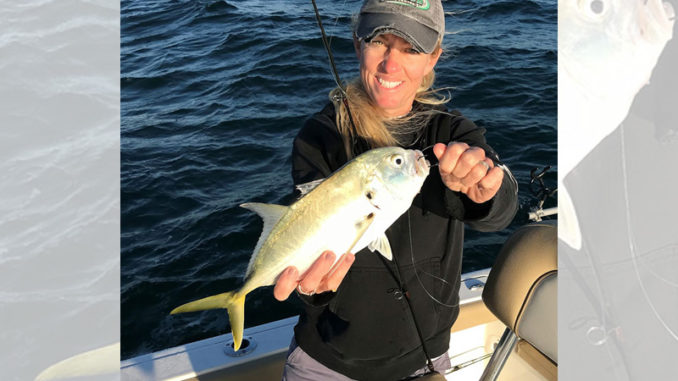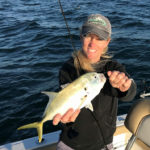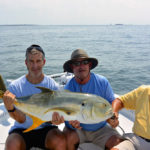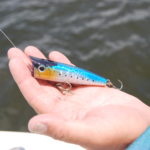
Charleston Harbor is a great spot to do battle with a summer visitor: the tackle-busting jack crevalle. Don’t miss the opportunity.
From a biological standpoint, not a whole lot is known about one of the most-abundant, subtropical saltwater species as it relates to South Carolina.
In south Florida, the jack crevalle, also known as a common jack or yellow cavalla, is so common it’s often considered a nuisance fish.
Jack crevalle spawn in the subtropical waters of the Florida Strait and the Caribbean Sea. Larvae are carried to South Carolina waters by the Gulf Stream each spring and summer. And the fish move to South Carolina only during the summer when water temperatures are at their peak. Based on these circumstances, it would stand to reason that jacks in the 1- to 2-pound range would be the norm. But for reasons local guides have a hard time explaining, an 3-pound jack is a small one. Most of the specimens caught around Charleston Harbor are in the 20-pound range.
“People catch them along the beaches and off the piers during the summer. But my experience has been seeing them schooling and catching them inside Charleston Harbor,” said guide Justin Carter of Redfin Charters. “You see them mostly early and late in the day when the water is calmer, and they’ll be busting on the surface.”
Stay prepared to see jacks, even when not targeting them
Like most anglers, Carter couldn’t explain why the average jack in the harbor is so big, but he’s not complaining. Unless requested by one of his clients, Carter rarely sets out just to catch jacks. They are usually an opportunity fish when he sees them schooling while crossing the harbor.
That’s why he tries to keep a large surface chugger or Super Spook tied on at least one rod and at the ready. When he spots surface activity, he’ll come off the throttle before he gets there. He’ll cast the noisy surface bait past the commotion and start working it back toward the boat. Bites are frequently explosive on the surface.
“It’s pretty simple really. The fish seem to like fast, moving water around a point where they can ambush baitfish being swept along by the current,” he said. “You hardly ever see one by itself, so if you see one bust, it’s pretty common there’s 10 or 15 in there with him.”
Carter said his No. 2 time to encounter jacks is when he’s free-lining live menhaden, either on flat lines or under a cork. Like when he’s targeting tarpon or some other surface-feeding fish.
“We catch them from time to time when we’re anchored up or on spot lock and I have baits out the back of the boat in the current,” he said.
Live bait also works well
For live-bait fishing, Carter prefers to hook the menhaden under the anal fin so it’s swimming away from him. He uses 50-pound braid for his main line, attached to a 15-foot leader of 60-pound mono and a 5/0 hook.
“If I see them working and decide to use live bait, I’ll nose-hook the menhaden. I can cast them further that way,” he said. “Otherwise I find they swim better in the current if they’re hooked near the tail.”
Jacks may not be a desirable fish for the dinner table, but their aggressive nature makes them highly desired by fly fishermen. Charleston guide John Irwin of Fly Right Charters said a 10-weight rod, floating line, and a 5- to 6-foot section of straight, 60-pound leader is appropriate for tackling big jacks.
“The fish are aggressive but can be spooky if you run the boat right up into them,” Irwin said. “It’s best to ease in or get ahead of them and let the school come to you.”
Make some noise
Depending on his client’s preference for tackle, he’ll tie on an Orca 90 popper for 30-pound spinning tackle or a Rainey’s mini-teaser for fly tackle. The Rainey’s popper is an epoxy covered, foam bait with a concave head on a 3/0 to 4/0 hook. Irwin said whether you go with fly or spinning tackle, you need to make some noise with the bait.
“I throw across them, sort of lead them, but you want to make some splash. That’s why I like the popper head, to move some water. A walk-the-dog style bait doesn’t make enough splash,” he said.
One of the hazards of targeting a schooling species is that when hooked, the fish dives back into the school, and the angler’s line is highly susceptible to being cut off by the razor sharp tail and anal fins of it’s school mates.
Like Carter, Irwin can’t explain the discrepancy in the size of jacks in Charleston area waters.
“We do catch little ones — 2- or 3-pounders — usually on live bait. But I think they all just migrate up during the summer,” he said. “The big ones we catch, the 20- and 30-pounders, are bruisers. They’ve been around the block. Most of them look old and beat up.”
DESTINATION INFORMATION
WHEN TO GO — Jack Crevalle make their annual appearance in Charleston Harbor from late July through early September — when water temperatures are at their highest.
HOW TO GET THERE — A handful of public boat ramps service the Charleston Harbor area: Remley’s Point and Shem Creek in Mount Pleasant and Wappoo Cut in West Ashley.
BEST TECHNIQUES — Few anglers target jack crevalle, but many will stop and fish for them when and where they find them. Jacks congregate in Charleston Harbor on incoming tides and further out, around Castle Pinckney, on outgoing tides. Look for surface activity early and late. Topwater chugging baits in the 4- to 5-inch range are a good choice. Make sure the baits make plenty of noise to get the fish’s attention. Jacks can also be targeted with live bait on free lines or under corks if it’s known the school is in the area but not on the surface.
FISHING INFO/GUIDES — Justin Carter, Redfin Charters, 843-725-8784, www.inshore-fishingcharters.com; John Irwin, Fly Right Chartres, 843-860-4231, www.flyrightcharters.com See also Guides & Charters in Classifieds.
ACCOMMODATIONS — Best Western Patriot’s Point, Mount Pleasant, 843-971-7070; Town and Country Inn & Conference Center, Charleston, 800-334-6660; La Quinta Inn & Suites, Charleston, 843-556-5200.
MAPS — Maps Unique, 910-458-9923, www.mapsunique.com; Sealake Fishing Guides, 800-411-0185, www.thegoodspots.com.




